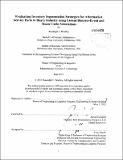| dc.contributor.advisor | Jarrod Goentzel. | en_US |
| dc.contributor.author | Bradley, Randolph L. (Randolph Lewis) | en_US |
| dc.contributor.other | Massachusetts Institute of Technology. Engineering Systems Division. | en_US |
| dc.date.accessioned | 2013-03-01T15:07:21Z | |
| dc.date.available | 2013-03-01T15:07:21Z | |
| dc.date.copyright | 2012 | en_US |
| dc.date.issued | 2012 | en_US |
| dc.identifier.uri | http://hdl.handle.net/1721.1/77459 | |
| dc.description | Thesis (M. Eng. in Logistics)--Massachusetts Institute of Technology, Engineering Systems Division, 2012. | en_US |
| dc.description | Vita. Cataloged from PDF version of thesis. | en_US |
| dc.description | Includes bibliographical references (p. 104-106). | en_US |
| dc.description.abstract | Heavy industries operate equipment having a long life to generate revenue or perform a mission. These industries must invest in the specialized service parts needed to maintain their equipment, because unlike in other industries such as automotive, there is often no aftermarket supplier. If parts are not on the shelf when needed, equipment sits idle while replacements are manufactured. Stock levels are often set to achieve an off-the-shelf fill rate goal using commercial inventory optimization tools, while supply chain performance is instead measured against a speed of service metric such as order fulfillment lead time, the time from order placement to customer receipt. When some parts are more important than others, and shipping delays are accounted for, there is ostensibly little correlation between these two metrics and setting stock levels devolves into an inefficient and expensive guessing game. This thesis resolves the disconnect between stock levels and service metrics performance by linking an existing discrete-event simulation of warehouse operations to a new Monte Carlo demand categorization and metrics simulation, predicting tomorrow's supply chain performance from today's logistics data. The insights gained here through evaluating an industry representative dataset apply generally to supply chains for aftermarket service parts. The simulation predicts that the stocking policy recommended by a simple strategy for inventory segmentation for consumable parts will not achieve the desired service metrics. An internal review board that meets monthly, and a quarterly customer acquisition policy, each degrade performance by imposing a periodic review policy on stock levels developed assuming a continuous review policy. This thesis compares the simple strategy to a sophisticated strategy for inventory segmentation, using simulation to demonstrate that with the latter, metrics can be achieved in one year, inventory investment lowered 20%, and buys for parts in low annual usage categories automated. | en_US |
| dc.description.statementofresponsibility | by Randolph L. Bradley. | en_US |
| dc.format.extent | 113 p. | en_US |
| dc.language.iso | eng | en_US |
| dc.publisher | Massachusetts Institute of Technology | en_US |
| dc.rights | M.I.T. theses are protected by
copyright. They may be viewed from this source for any purpose, but
reproduction or distribution in any format is prohibited without written
permission. See provided URL for inquiries about permission. | en_US |
| dc.rights.uri | http://dspace.mit.edu/handle/1721.1/7582 | en_US |
| dc.subject | Engineering Systems Division. | en_US |
| dc.title | Evaluating inventory segmentation strategies for aftermarket service parts in heavy industry using linked discrete-event and Monte Carlo simulations | en_US |
| dc.type | Thesis | en_US |
| dc.description.degree | M.Eng.in Logistics | en_US |
| dc.contributor.department | Massachusetts Institute of Technology. Engineering Systems Division | |
| dc.identifier.oclc | 826902494 | en_US |
